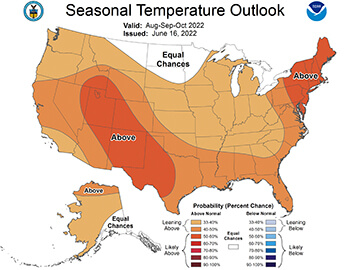 July was certainly a brutal month for north Georgia. Temperatures were scorching. Humidity frequently gave us heat indices in the 100- to 110-degree range. Rainfall was either hit or miss, as is typical with afternoon storms in July. What was not typical was the amount of rain that fell with these powerhouse storms.
July was certainly a brutal month for north Georgia. Temperatures were scorching. Humidity frequently gave us heat indices in the 100- to 110-degree range. Rainfall was either hit or miss, as is typical with afternoon storms in July. What was not typical was the amount of rain that fell with these powerhouse storms.
The tropical air piled over north Georgia with an “atmospheric pipeline” off the Gulf of Mexico. I remember specifically, we had one slow-moving thunderstorm a few miles east of Buford Dam on July 13th. I had to verify this twice, but yes, this storm produced 2.9 inches of rain in 45 minutes! To put that into perspective, on average, our normal rainfall for the entire month of July is 4.7 inches.
Based on the past 30 years, the average rainfall for August is 3.67 inches. Our average low for early August is 69.9 degrees with an average high temperature of 87.9 degrees.
We are also now in the Dog Days of Summer, which began on July 3rd. They continue until August 11th. They’re usually the hottest and most unbearable days of the season. We often hear about the “Dog Days” of summer, but few know where the expression originated. Some think it’s a reference to the hot, sultry days that are “not fit for a dog.” Others suggest it’s the time of year when the extreme heat drives dogs mad. The Dog Days are actually based on the stars.
The phrase is a reference to Sirius, the Dog Star. During the “Dog Days” the Sun is in the same region of the sky as Sirius. Sirius is the brightest star visible from any part of Earth and part of the constellation Canis Major, the Greater Dog.
In the summer, Sirius rises and sets with the Sun. On July 23rd, specifically, it is in conjunction with the Sun, and because the star is so bright, the ancient Romans believed it actually gave off heat and added to the Sun’s warmth, accounting for the long stretch of sultry weather. They referred to this time as the “Dog Days.” They were keenly aware of what was happening in the heavens. So it has come to be that the Dog Days of Summer are the 20 days before and 20 days after this alignment of Sirius with the Sun – July 3 to August 11 each year. And now you know!
We also have some other astronomical events in August you might be interested in. On August 12-13 we have one of the best meteor showers of the year. The Perseid Meteor Shower can produce up to 60 shooting stars per hour and is famous for producing a large number of fireballs, very bright meteors.
On August 12, we will also have the Full Supermoon, the Sturgeon Moon. This is the last of three supermoons this year, which are about 30 percent brighter than your typical full moon. This could interfere with being able to see some of the Perseid meteors.
Many of you have been looking forward to fall since last month! I would not get too excited about cooler temperatures because it will likely continue to be above average, as you can see in the latest outlook from the Climate Prediction Center. As far as rainfall goes, there just are not enough signals in the atmosphere to determine above or below average rainfall, which is why the prediction is for equal chances.





